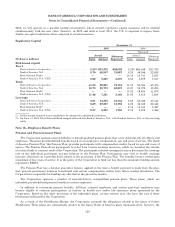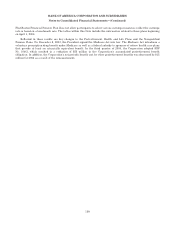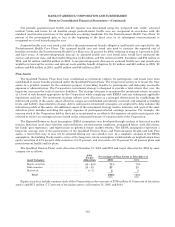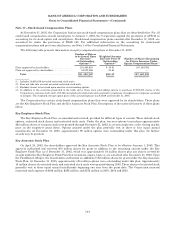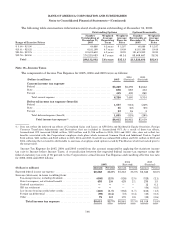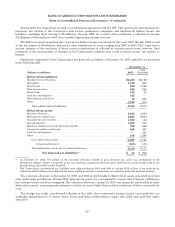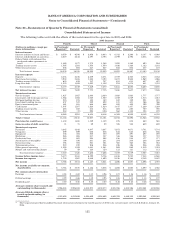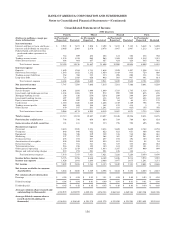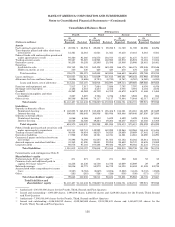Bank of America 2005 Annual Report Download - page 184
Download and view the complete annual report
Please find page 184 of the 2005 Bank of America annual report below. You can navigate through the pages in the report by either clicking on the pages listed below, or by using the keyword search tool below to find specific information within the annual report.BANK OF AMERICA CORPORATION AND SUBSIDIARIES
Notes to Consolidated Financial Statements—(Continued)
The American Jobs Creation Act of 2004 (the Act) provides U.S. companies with the ability to elect to apply a special
one-time tax deduction equal to 85 percent of certain earnings remitted from foreign subsidiaries, provided certain
criteria are met. Management elected to apply the Act for 2005 and recorded a one-time tax benefit of $70 million for the
year ended December 31, 2005.
At December 31, 2005 and 2004, federal income taxes had not been provided on $1.4 billion and $1.1 billion of
undistributed earnings of foreign subsidiaries, earned prior to 1987 and after 1997 that have been reinvested for an
indefinite period of time. If the earnings were distributed, an additional $249 million and $221 million of tax expense,
net of credits for foreign taxes paid on such earnings and for the related foreign withholding taxes, would result in 2005
and 2004.
Note 19—Fair Value of Financial Instruments
SFAS No. 107, “Disclosures About Fair Value of Financial Instruments” (SFAS 107), requires the disclosure of the
estimated fair value of financial instruments. The fair value of a financial instrument is the amount at which the
instrument could be exchanged in a current transaction between willing parties, other than in a forced or liquidation
sale. Quoted market prices, if available, are utilized as estimates of the fair values of financial instruments. Since no
quoted market prices exist for certain of the Corporation’s financial instruments, the fair values of such instruments
have been derived based on management’s assumptions, the estimated amount and timing of future cash flows and
estimated discount rates. The estimation methods for individual classifications of financial instruments are described
more fully below. Different assumptions could significantly affect these estimates. Accordingly, the net realizable values
could be materially different from the estimates presented below. In addition, the estimates are only indicative of the
value of individual financial instruments and should not be considered an indication of the fair value of the combined
Corporation.
The provisions of SFAS 107 do not require the disclosure of the fair value of lease financing arrangements and
nonfinancial instruments, including intangible assets such as goodwill, franchise, and credit card and trust
relationships.
Short-term Financial Instruments
The carrying value of short-term financial instruments, including cash and cash equivalents, time deposits placed,
federal funds sold and purchased, resale and repurchase agreements, commercial paper and other short-term
investments and borrowings, approximates the fair value of these instruments. These financial instruments generally
expose the Corporation to limited credit risk and have no stated maturities or have short-term maturities and carry
interest rates that approximate market.
Financial Instruments Traded in the Secondary Market
Held-to-maturity securities, AFS debt and marketable equity securities, trading account instruments and long-term
debt traded actively in the secondary market have been valued using quoted market prices. The fair values of trading
account instruments and securities are reported in Notes 4 and 6 of the Consolidated Financial Statements.
Derivative Financial Instruments
All derivatives are recognized on the balance sheet at fair value, net of cash collateral held and taking into
consideration the effects of legally enforceable master netting agreements that allow the Corporation to settle positive
and negative positions with the same counterparty on a net basis. For exchange-traded contracts, fair value is based on
quoted market prices. For non-exchange traded contracts, fair value is based on dealer quotes, pricing models or quoted
prices for instruments with similar characteristics. The fair value of the Corporation’s derivative assets and liabilities is
presented in Note 5 of the Consolidated Financial Statements.
Loans
Fair values were estimated for groups of similar loans based upon type of loan and maturity. The fair value of loans
was determined by discounting estimated cash flows using interest rates approximating the Corporation’s current
origination rates for similar loans and adjusted to reflect the inherent credit risk. Where quoted market prices were
available, primarily for certain residential mortgage loans and commercial loans, such market prices were utilized as
estimates for fair values.
Substantially all of the foreign loans reprice within relatively short timeframes. Accordingly, for foreign loans, the
net carrying values were assumed to approximate their fair values.
148


